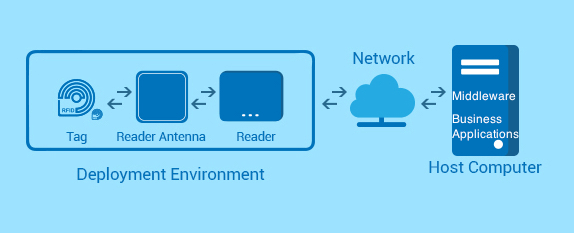Preparation for RFID Certification Exam
Cheat Sheet – RFID Architecture Components
MAIN OBJECTIVES
- Know the components of an RFID System
- How each of these components is connected to one or more of the other components
- What role each component plays in the overall RFID architecture
- What physical forms the components may take (for example handheld versus fixed readers)
Download the Cheat Sheet in PDF
COMPONENTS OF AN RFID SYSTEM
- Reader (also known as an Interrogator) – to read and write to tags
- One or more reader antennas – transmits the reader power and commands to tags and receives data from tags
- Cable to connect reader antennas to the reader (unless the antenna is integrated into the reader)
- Tags that are placed on or in an object
- A software application to transfer data from the reader to the system that will process the data, usually referred to as the “middleware”
Additional components can include:
- RFID Printer Encoder – to print labels and encode RFID tags
- Barcode Scanner – to scan barcode labels for association with the RFID tag
- Input/Output Devices – light stacks, sounds devices, triggers and sensors
- System applications (that often encompass some or all middleware functions) and enterprise applications.

RFID System Components
RFID READER/INTERROGATOR FUNCTIONS
- Readers perform air interface functions
- Read/write data from/to tags via an antenna
- Anti-collision, filtering
- Work with one tag at a time, but very quickly
- Perform reader management functions
- Have firmware that runs the reader
- Often include a basic user interface with user application for reader configuration
- Communicate over the network with host computers
- Usually support multiple protocols (EPC and ISO)
- Can run light controls, motion sensors, electric eyes, horns and other I/Os
- Come in various form factors:
- Primary form factors are fixed and handheld,
- Fixed can be regular or integrated (these have integrated antenna),
- Handheld can be fully equipped handheld computers with a display but also be sled readers that are just RFID base and the computing is provided by a docked smartphone with an app.
- Fixed readers may have multiple antenna ports, usually 1 – 4 but sometimes 8 or 16.
- Bi-static, Mono-static
- Battery, AC, or Ethernet powered (POE)
- Dumb, Smart
- Serial or Ethernet (wired, wireless) connection, sometimes Bluetooth (handheld)
RFID TAGS
- Passive, semi-passive, active
- Various frequencies – LF, HF, UHF, Microwave, UWB
- Performance dependent on environment, tagged materials and tag position
- Environment
- A lot of metal – reflections, interference, diminished read range, or reading what’s not desired – solved by shielding, tuning, antenna tilt.
- A lot of water or aqueous liquids/moist materials (incl. wood) – detuning, absorption, diminished read range – design considerations like line of sight, tuning power, angling antennas and adding read points.
- Other readers in the environment – interference, diminished read range, data rate, tag reads – solved by dense reader mode, tuning power, gain, etc.
- Tagged materials – can interfere with tag operation due to detuning the tag
- Metals – tag is detuned to the point that it does not respond (the metal surface interferes with the tag’s antenna), in addition metal blocks signal
- Aqueous liquids in thin containers, condensation or moist materials – tag is detuned
- Solution – use tags specifically tuned/made for metals or moist materials – these are specifically tuned and/or offset from surface to ensure a proper performance
- Tag position – sometimes the tag can be placed in a position where the RF signal from the reader has hard time powering it. The tag must be (as much as possible) parallel to the surface of the reader antenna (perpendicular to the RF waves) and if linear antenna is use, the tag’s dipole has to be in the same plane.
ANTENNA FUNCTIONS
- Transmit the reader’s interrogation signal
- Receive the return signal from the tag
- Come in various sizes and shapes
- Are connected to the reader via a cable (unless integrated)
- Size depends on frequency
- As frequency increases, wavelength and antenna size decrease
- By increasing antenna size, you can increase its read range
- They are designed for a specific gain (higher the gain the narrower the beam and vice versa).
RFID MIDDLEWARE
- Manages hardware devices and communicates between readers and business applications
- Transfers, formats, filters and distributes data between the reader and the system application
- It’s a set of many different distributed software elements: Event Management, Data Conversion, Database Management, Data Consolidation, Data Reporting, etc.
- Refers to all the software laying between the on-device software and the business applications
- Does not manage compliance with standards and regulations which is already managed by the reader firmware.